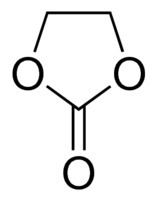Density 1.32 g/cm³ Appearance White to yellow solid | Formula C3H4O3 | |
 | ||
Global and china ethylene carbonate industry 2013 market research report
Ethylene carbonate is the organic compound with the formula (CH2O)2CO. It is classified as the carbonate ester of ethylene glycol and carbonic acid. At room temperature (25 °C) ethylene carbonate is a transparent crystalline solid, practically odorless and colorless, and somewhat soluble in water. In the liquid state (m.p. 34-37 °C) it is a colorless odorless liquid.
Contents
- Global and china ethylene carbonate industry 2013 market research report
- Production and reactions
- Applications
- References
Production and reactions
Ethylene carbonate is produced by the reaction between ethylene oxide and carbon dioxide. The reaction is catalyzed by a variety of cations and complexes:
(CH2)2O + CO2 → (CH2O)2COEthylene carbonate (and propylene carbonate) may be converted to dimethyl carbonate (a useful solvent and a mild methylating agent) via transesterification by methanol:
C2H4CO3 + 2 CH3OH → CH3OCO2CH3 + HOC2H4OHDimethyl carbonate may itself be similarly transesterified to diphenyl carbonate, a phosgene-substitute:
CH3OCO2CH3 + 2 PhOH → PhOCO2Ph + 2 MeOHApplications
Ethylene carbonate is used as a polar solvent with a molecular dipole moment of 4.9 D, only 0.1 D lower than that of propylene carbonate. It can be used as a high permittivity component of electrolytes in lithium batteries.
Ethylene carbonate is also used as plasticizer, and as a precursor to vinylene carbonate, which is used in polymers and in organic synthesis.
